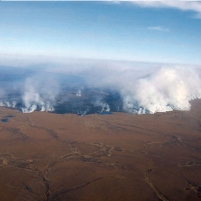Climate Change Brings New Threat to Arctic: Wildfires
Friday, July 29, 2011
 Anaktuvuk River Fire (photo: U.S. Bureau of Land Management)
Anaktuvuk River Fire (photo: U.S. Bureau of Land Management)
Call it the reversal of hell freezing over: the burning of frozen wasteland.
Only it’s already happened.
With global warming causing ice to melt at record rates in the Arctic, Alaska’s tundra has become exposed to the threat of wildfires. Scientists say the burning of permafrost can mean the release of large amounts of carbon into the atmosphere, which adds to the impact of climate change.
For example, Alaska’s northern frontier experienced an enormous wildfire in 2007 that burned about 400 square miles. The area consumed was double the amount that all other fires had burned in the Arctic from 1950 to 2006.
Researchers say the Anaktuvuk fire burned down to a maximum depth of six inches of soil, releasing carbon that had been contained in the earth for more than 50 years.
-Noel Brinkerhoff
Huge Arctic Fire Hints at New Climate Cue (by Richard Black, BBC News)
2007 Arctic Wildfire Released 50 Years of Stored Carbon into Atmosphere (by Doug O’Harra, Alaska Dispatch)
Carbon Loss from an Unprecedented Arctic Tundra Wildfire (by Michelle Mack, M. Syndonia Bret-Harte, Teresa Hollingsworth, Randi Jandt, Edward Schuur, Gaius Shaver and David Verbyla, Nature) (abstract)
- Top Stories
- Unusual News
- Where is the Money Going?
- Controversies
- U.S. and the World
- Appointments and Resignations
- Latest News
- Musk and Trump Fire Members of Congress
- Trump Calls for Violent Street Demonstrations Against Himself
- Trump Changes Name of Republican Party
- The 2024 Election By the Numbers
- Bashar al-Assad—The Fall of a Rabid AntiSemite






Comments